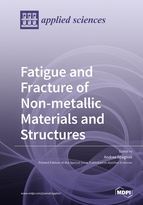Fatigue and Fracture of Non-metallic Materials and Structures
A special issue of Applied Sciences (ISSN 2076-3417). This special issue belongs to the section "Mechanical Engineering".
Deadline for manuscript submissions: closed (15 July 2019) | Viewed by 115532
Special Issue Editor
Special Issue Information
Dear Colleagues,
The mechanics of fracture and fatigue have produced a huge body of research work in relation to applications to metal materials and structures. However, a variety of non-metallic materials (e.g., concrete and cementitious composites, rocks, glass, ceramics, bituminous mixtures, composites, polymers, rubber and soft matters, bones and biological materials, advanced and multifunctional materials) have received comparatively less attention, despite their attractiveness for a large spectrum of applications related to the components and structures of diverse engineering branches, applied sciences and architecture, and to the load-carrying systems of biological organisms.
This Special Issue covers the broad topic of structural integrity of non-metallic materials, and it is concerned with the modelling, assessment and reliability of structural elements of any scale. Original contributions from engineers, mechanical materials scientists, computer scientists, physicists, chemists, and mathematicians are encouraged. Both experimental and theoretical papers are welcome.
Prof. Dr. Andrea Spagnoli
Guest Editor
Manuscript Submission Information
Manuscripts should be submitted online at www.mdpi.com by registering and logging in to this website. Once you are registered, click here to go to the submission form. Manuscripts can be submitted until the deadline. All submissions that pass pre-check are peer-reviewed. Accepted papers will be published continuously in the journal (as soon as accepted) and will be listed together on the special issue website. Research articles, review articles as well as short communications are invited. For planned papers, a title and short abstract (about 100 words) can be sent to the Editorial Office for announcement on this website.
Submitted manuscripts should not have been published previously, nor be under consideration for publication elsewhere (except conference proceedings papers). All manuscripts are thoroughly refereed through a single-blind peer-review process. A guide for authors and other relevant information for submission of manuscripts is available on the Instructions for Authors page. Applied Sciences is an international peer-reviewed open access semimonthly journal published by MDPI.
Please visit the Instructions for Authors page before submitting a manuscript. The Article Processing Charge (APC) for publication in this open access journal is 2400 CHF (Swiss Francs). Submitted papers should be well formatted and use good English. Authors may use MDPI's English editing service prior to publication or during author revisions.
Keywords
- Fatigue
- Fracture mechanics
- Structural integrity
- Polymers
- Composites
- Ceramics
- Concrete
- Rock
- Soft matter
- Advanced materials






